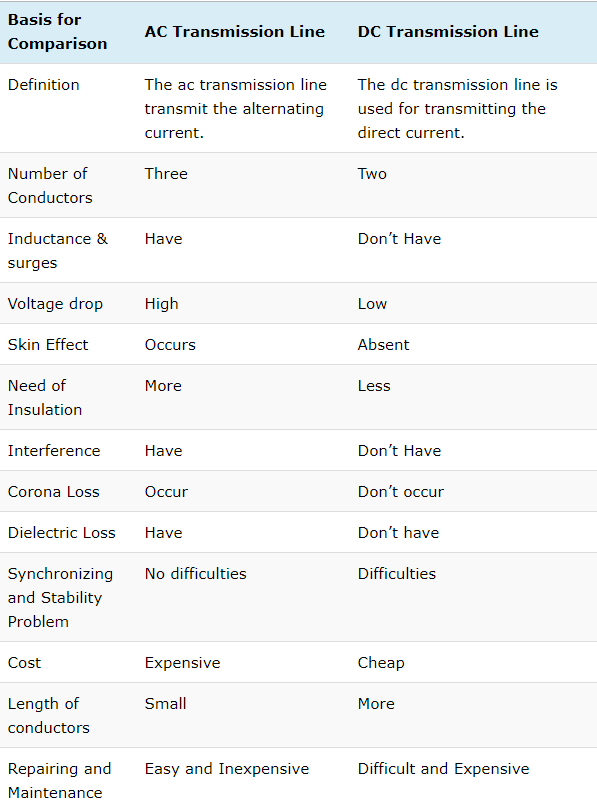AC voltage is capable of converting voltage levels with just a transformer, making it far easier to transport across great distance than DC, whose conversion requires more complex electronic circuitry.
Power = Volts X Amps X PF,
The Higher the Voltage Level, the more Power can be delivered to the Customers, for the same amount of Current.
Only so much Current can go through a Cable without Heating up. That is why Power Companies use Voltage Levels exceeding 1,000,000 Volts today.
The article has one true point and that is that AC can take advantage of Transformers to Step up the Voltage at the Power Station and Step it Down at the Customer, City or Factory.
Those cheap Transformers can cost $10 Million for two 500 MVA Transformers, one at the Power Company and one near the Load. For a 500 MVA DC System, a DC Convertor and Invertor Pair may cost $45 Million.
Therefore, DC with it’s Unity Power Factor, is used when the distance of the Power Transmission exceeds 500 Miles. This is because AC is effected by the Resistance, and the Capacitive and Inductive Reactance Losses of the Transmission Line, DC is only effected by the Resistance Losses of the Cables. DC requires Convertors at the Power Company and Invertors at the Customer.
To justify and offset the cost of the DC Conversion/Inversion, the Transmission Line length must be greater than 500 Miles for 2 DC Cables to be cheaper than 3 Phase AC Cables.
Also, keep in mind that Transformers hold up better when Lightning strikes than do Power Electronic Devices.
Finally, when Power Convertors are safe enough that when they fail, they do not cause House Fires, it will not matter if the House is wired for AC or DC, or both.
But knowing that Power Companies like to save money and keep it simple, AC is going to be around for a very long time, in Homes, Businesses, and Factories. (until one of you propeller heads invents the Mr. Fusion Home Reactor)
DC is used in extra high (EHV) and ultra high (UHV) power transmission (500,000V and up) for the following reasons:
It is asynchronous . That is, becuase DC has no frequency, it can be used to connect two differnent systems without worrying about having to synchronize the systems.
The DC connection is a open circuit to AC systems . This is important when it comes to system stability-having that isolation helps to separate two separate systems in the event of a electrical fault event, such as lightning or equipment failure. The DC circuit limits the fault’s path, essentially protecting the unfaulted part of the system it is connected to.
For long distances, it is more economical. DC transmission towers take up less space which means less land can be used for right of way. Since DC only needs two poles at a maximum (sometimes one pole is used, and the ground is used as a return), less wire is needed. Towers are also more economical since they dont’ have to carry three separate wires.
Fewer losses. With a DC system, there are fewer losses–there is no reactive component to a DC circuit, so AC system- related losses like capacitive, inductive and skin effect are nonexistent. Again because there is no AC, losses and other issues associated with electrical coupling/induced currents are not an issue. There are only resistive losses as opposed to AC, which has reactive and resistive losses.
Easy to transfer large blocks of power . With DC, direction of power can be switched easier. This makes DC indispensable for areas where summer loadings and winter loadings are opposite-for example a state that is cooler in winter in one area and warmer in summer in another area. The DC circuit could be used to export power to the colder region in the winter from the warmer region, and from the cooler region to the warmer region in summer. Inverters are used to change the direction of power instantanously, as well as the amount of power transmitted.
The disadvantages are:
Cost. DC installations are very expensive, which is one reason why they don’t really get used below transmission voltage level. A DC substation requires more equipment than an AC substation would require, partially becuase the conversion process requires equipment that will eliminate harmonics that are created. This is very inefficient for subtransmission and tranmission voltages below 500kV (500,000V).
AC power is easier to step up and down . There is no such thing as a DC transformer, since transfomers require an alternating magnetic field to work. DC current, since there is no frequency, cannot produce the induced current in the secondary coil of the transformer. Transformation is an essential part of the AC power system, so this inability is a very significant negative.
Because of the disadvantages, DC transmission in the US is still not common it is very limited in scope, and is not generally used for voltages below 500kV. But in Europe it is decidedly more common. The asynchronous nature, as well as the particular areas, make DC connections a more suitable choice there than here in the US.
